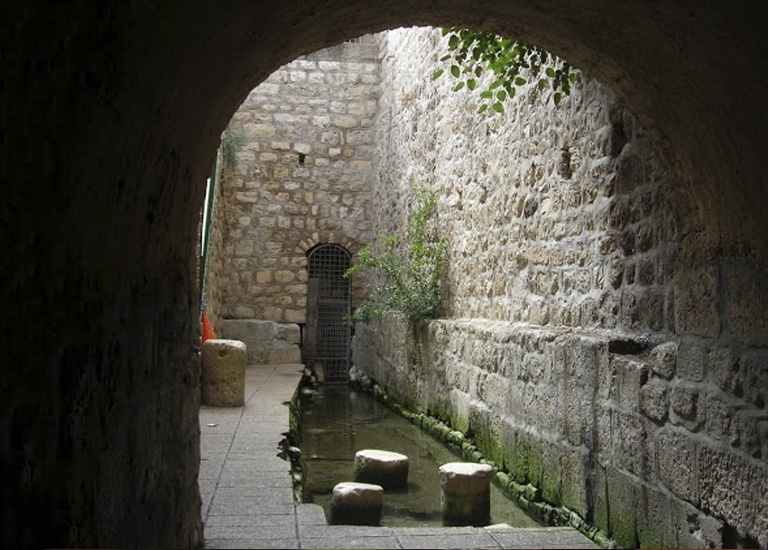Hezekiah’s Tunnel
 This week’s blog is excerpted from my new non-fiction book, Pilgrimage: My Journey to a Deeper Faith In the Land Where Jesus Walked. (Bethany House Copyright 2013)
This week’s blog is excerpted from my new non-fiction book, Pilgrimage: My Journey to a Deeper Faith In the Land Where Jesus Walked. (Bethany House Copyright 2013)
Hezekiah’s Tunnel
 The icy water takes my breath away. I wade into it, stepping down, and down again, until it reaches my thighs. But the shivery water isn’t the worst part of this trek through King Hezekiah’s tunnel. There is no light in here, electric or natural, and the claustrophobic tunnel meanders underground as if excavated by drunkards. Ahead of me, a tall man stoops to keep from smacking his head on the stone ceiling. A heavyset woman looks as though she regrets this adventure as she squeezes between the slimy walls. None of us can turn back. There’s only enough room to walk single file.
The icy water takes my breath away. I wade into it, stepping down, and down again, until it reaches my thighs. But the shivery water isn’t the worst part of this trek through King Hezekiah’s tunnel. There is no light in here, electric or natural, and the claustrophobic tunnel meanders underground as if excavated by drunkards. Ahead of me, a tall man stoops to keep from smacking his head on the stone ceiling. A heavyset woman looks as though she regrets this adventure as she squeezes between the slimy walls. None of us can turn back. There’s only enough room to walk single file.
This water system, deep below the city of Jerusalem, is manmade. The Bible tells us that “It was Hezekiah who blocked the upper outlet of the Gihon spring and channeled the water down to the west side of the City of David” (2 Chronicles 32:30). I know the story well. The first novel I ever wrote, Gods and Kings, was part a three-book series about the life of King Hezekiah, who reigned in Jerusalem seven hundred years before Christ. With no supply of fresh water in the city and the vicious Assyrian army marching toward him, Hezekiah needed to find a way to safeguard the freshwater spring, located outside the city walls. His solution was to dig an underground tunnel from the spring to a new reservoir within the walls. Pressured to complete the work before the Assyrians attacked, he ordered the workers to start digging from opposite ends and meet in the middle.
 “Hey, is it safe to trust a tunnel that was dug 2,700 years ago?” someone asks as we slosh forward. I shake my head but no one sees me in the dark. No. I don’t trust an ancient tunnel, especially in a city that has occasional earthquakes. I can only trust God—and keep moving, shining my feeble flashlight. The chiseled floor is uneven and rough, and since we can’t see our feet below the inky water, we shuffle slowly, careful not to stumble and fall. I’m not a big fan of caves, and this manmade one with its straight walls and squared-off ceiling is dark and creepy. The weight of the mountain above my head feels crush
“Hey, is it safe to trust a tunnel that was dug 2,700 years ago?” someone asks as we slosh forward. I shake my head but no one sees me in the dark. No. I don’t trust an ancient tunnel, especially in a city that has occasional earthquakes. I can only trust God—and keep moving, shining my feeble flashlight. The chiseled floor is uneven and rough, and since we can’t see our feet below the inky water, we shuffle slowly, careful not to stumble and fall. I’m not a big fan of caves, and this manmade one with its straight walls and squared-off ceiling is dark and creepy. The weight of the mountain above my head feels crush ing.
ing.
“How much farther?” someone asks in a shaky voice. I don’t dare tell her that this serpentine tunnel will wind for nearly a third of a mile and take about half an hour to walk through. The college students in our group try to lighten the atmosphere with laughter and jokes. Then one of them starts to sing: “Fill it up and let it overflow . . .” It’s an upbeat version of “Amazing Grace” with an added refrain, “Fill it up and let it overflow, let it overflow with love.” Soon, everyone joins in.
 We reach the middle and stop to see the spot where the two tunnels met. Here, chiseled into the rock, was the oldest Hebrew inscription ever discovered, written by Hezekiah’s men to explain how they had broken through after digging from opposite ends. The inscription is in a museum in Turkey, not here. We shine our flashlights on the wall and see where it once was, and also how the chisel marks slant from opposite directions at the meeting point.
We reach the middle and stop to see the spot where the two tunnels met. Here, chiseled into the rock, was the oldest Hebrew inscription ever discovered, written by Hezekiah’s men to explain how they had broken through after digging from opposite ends. The inscription is in a museum in Turkey, not here. We shine our flashlights on the wall and see where it once was, and also how the chisel marks slant from opposite directions at the meeting point.
This tunnel is an engineering marvel, especially when you consider that it was dug in 700 BC. Experts still aren’t sure how anyone could dig two meandering tunnels that began a third of a mile apart and get them to meet up in the middle, deep underground. Impossible! Everyone who hears the story and sees the tunnel is impressed with King Hezekiah and his men.
But God wasn’t impressed. He sent the prophet Isaiah to rebuke the king for all of his plans, saying, “You built a reservoir between the two walls for the water of the Old Pool, but you did not look to the One who made it, or have regard for the One who planned it long ago’” (Isaiah 22:11). In other words, Hezekiah was relying on his own preparations instead of trusting God.
Fifteen minutes later, a pinprick of light in the distance tells us we are almost to the end. I have a new respect for that old cliché about  seeing the light at the end of the tunnel. I hear a lot of grateful sighs, including my own, when we wade out into the blinding sunlight. As we sit in the sun to warm up and let our clothes dry out, I’m still thinking of Hezekiah.
seeing the light at the end of the tunnel. I hear a lot of grateful sighs, including my own, when we wade out into the blinding sunlight. As we sit in the sun to warm up and let our clothes dry out, I’m still thinking of Hezekiah.
 The city of Jerusalem was saved from the Assyrians, but not by this tunnel. When the most powerful army on earth surrounded Hezekiah, demanding surrender, he knew he’d reached the end of his resources. Facing an impossible situation, he went up to the Temple and knelt before God, placing his hope and trust in Him: “O Lord Almighty, God of Israel,” he prayed. “You alone are God over all the kingdoms of the earth . . . Now, O Lord our God, deliver us from [the enemy’s] hand, so that all kingdoms on earth may know that you alone, O Lord, are God” (Isaiah 37:16, 20). That night, the angel of the Lord walked among the sleeping Assyrian warriors and put to death a hundred and eighty-five thousand of them. At dawn, the horrified king of Assyria gathered up his few surviving soldiers and bolted for home.
The city of Jerusalem was saved from the Assyrians, but not by this tunnel. When the most powerful army on earth surrounded Hezekiah, demanding surrender, he knew he’d reached the end of his resources. Facing an impossible situation, he went up to the Temple and knelt before God, placing his hope and trust in Him: “O Lord Almighty, God of Israel,” he prayed. “You alone are God over all the kingdoms of the earth . . . Now, O Lord our God, deliver us from [the enemy’s] hand, so that all kingdoms on earth may know that you alone, O Lord, are God” (Isaiah 37:16, 20). That night, the angel of the Lord walked among the sleeping Assyrian warriors and put to death a hundred and eighty-five thousand of them. At dawn, the horrified king of Assyria gathered up his few surviving soldiers and bolted for home.
 It’s okay to make plans, but the lesson of Hezekiah’s tunnel is that when we put our trust in God, not only is He victorious but He is glorified. I think of the struggles I’ve experienced lately as life has veered out of my control, the times when I’ve panicked as the water has crept higher and higher until it seemed to reach my neck. In spite of all my feverish plans and schemes, the enemy has besieged and surrounded me, leaving me trapped with no way to escape. But as I sit in the sunlight outside Hezekiah’s tunnel, I think of God’s promise from Isaiah, the prophet in Hezekiah’s time: “Fear not, for I have redeemed you; I have summoned you by name; you are mine. When you pass through the waters, I will be with you; and when you pass through the rivers, they will not sweep over you” (Isaiah 43:1-2).
It’s okay to make plans, but the lesson of Hezekiah’s tunnel is that when we put our trust in God, not only is He victorious but He is glorified. I think of the struggles I’ve experienced lately as life has veered out of my control, the times when I’ve panicked as the water has crept higher and higher until it seemed to reach my neck. In spite of all my feverish plans and schemes, the enemy has besieged and surrounded me, leaving me trapped with no way to escape. But as I sit in the sunlight outside Hezekiah’s tunnel, I think of God’s promise from Isaiah, the prophet in Hezekiah’s time: “Fear not, for I have redeemed you; I have summoned you by name; you are mine. When you pass through the waters, I will be with you; and when you pass through the rivers, they will not sweep over you” (Isaiah 43:1-2).
 We can step into the deep water, the darkness, the unknown—and trust God. At the end of the tunnel, we will emerge into dazzling sunlight.
We can step into the deep water, the darkness, the unknown—and trust God. At the end of the tunnel, we will emerge into dazzling sunlight.
- 5352
- 5
- 0

